802.11b/g/n is defined in the 2.4GHz frequency band, and 802.11a/n/ac works in the 5GHz frequency band.
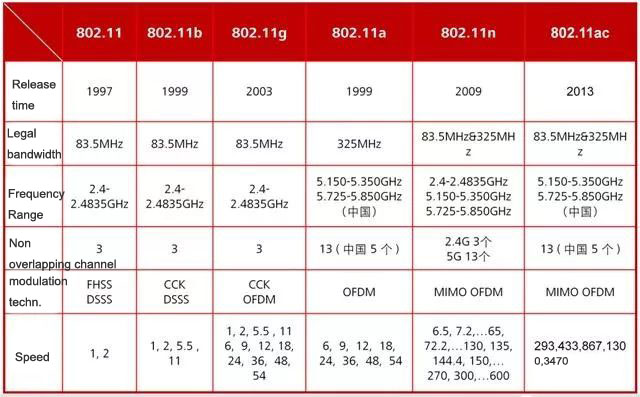
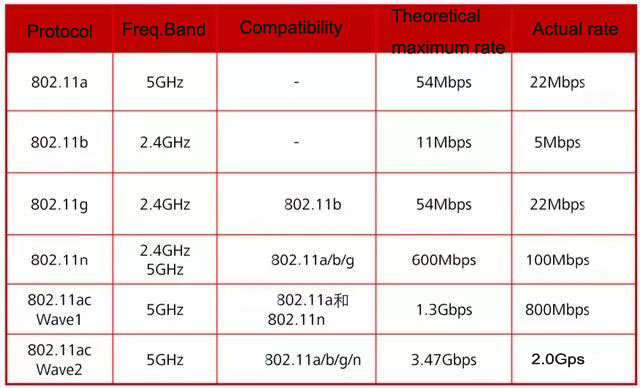
802.11:
It works in the 2.4G band and provides a transmission rate of 1 or 2 megabits per second
802.11b:
- Maximum 11Mbps throughput
- It operates at 2.4GHz and adopts direct sequence spread spectrum (DSSS)
- 802.11b is the most famous and popular standard among all WLAN standards. In the 2.4GHz ISM band, a total of 14 channels with a bandwidth of 22mhz are available, and the three channels do not overlap.

802.11g:
- 54Mbps maximum rate
- 802.11g operates in the 2.4GHz band
- 802.11g adopts orthogonal frequency division multiplexing (OFDM) and supports 6, 9, 12, 18, 24, 36, 48, 54Mbps data rate and 802.11b rate
- Support 13 channels
802.11a:
- The highest speed is 54Mbps
- 802.11a operates at 5GHz
- 802.11a adopts orthogonal frequency division multiplexing (OFDM) and supports data rates of 6, 9, 12, 18, 24, 36, 48 and 54 Mbps
802.11n:
- Up to 600mbps
- 802.11n protocol is dual-band working mode, supports 2.4GHz and 5GHz, and is compatible with 802.11a/b/g standard
- 802.11n adopts the combination of MIMO and OFDM
- The transmission distance is greatly increased
- Improve network throughput performance
802.11n advantages:
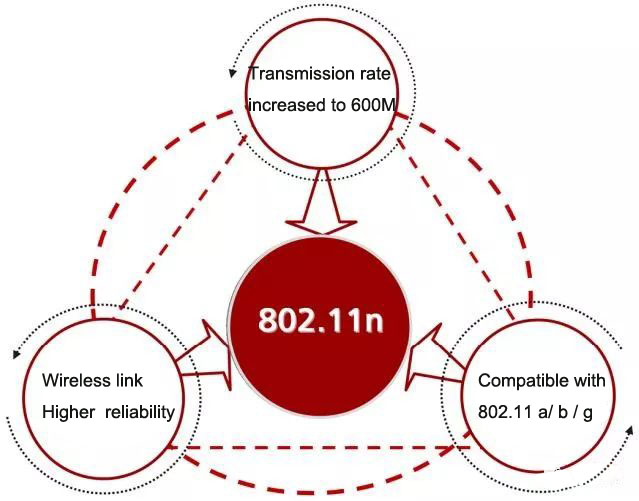
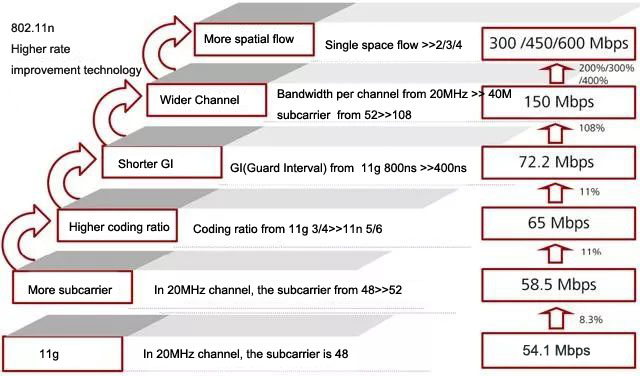
MIMO Technology
The wireless access point and client using 802.11a/b/g technology realize data transmission through a single antenna and a single spatial channel (SISO)
Wireless access points and clients using 802.11n technology can use two or more space division channels to transmit data at the same time. If the terminal also supports MIMO technology, multiple receiving antennas and advanced signal processing technology can be used to reconstruct the data sent from multiple channels
Multiple out technology is used to improve the signal-to-noise ratio of other MIMO terminals.
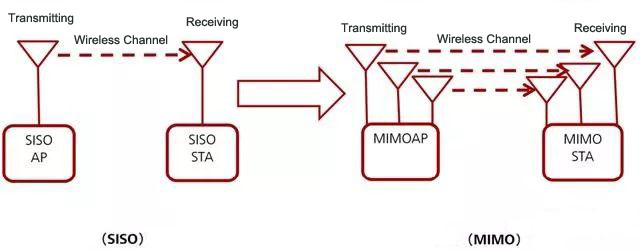
In a wireless communication system, a transmitter. The use of multiple antennas on the receiver opens up a new dimensional space. If this technology can be used correctly, it can greatly improve performance. It is now widely known as MIMO. Multiple antennas of the transmitter means that multiple signals are input into the wireless channel. Multiple antennas of the receiver mean that multiple signals are output from the wireless channel. The multi antenna receiver can separate and decode these data streams by using advanced space-time coding processing, so as to achieve the best processing and effectively resist spatial selective fading.
Beamforming technology: when there are multiple transmitting antennas at the transmitting end, adjust the signals sent from each antenna to significantly improve the signal strength at the receiving end.
MIMO antenna configuration is usually expressed as “m *n”, where m and N are integers
M indicates the number of transmission antennas
N indicates the number of receiving antennas
802.11n MAC layer improvement
802.11 MAC layer protocol consumes a lot of efficiency for link maintenance, which greatly reduces the throughput of the system. 802.11n reduces the fixed overhead and the loss caused by congestion by improving the MAC layer. Frame aggregation technology and block Confirmation Technology
Frame aggregation
802.11n introduces frame aggregation technology to improve the efficiency of MAC layer. Message frame aggregation technology includes:
- Mac service data unit aggregation A-MSDU
- MAC protocol data unit aggregation A-MPDU
The common point of the two aggregation methods is to reduce the load and only aggregate the frames of the same QoS level pair. However, the delay may be caused by waiting for the packets to be aggregated. In addition, only MPDU can use block confirmation.
MSDU aggregation
Mac service data units MSDU MAC service data units aggregation:
- Collect Ethernet frame aggregation
- Convert to 802.11 wireless frame
A-MSDU allows the aggregation of multiple packets with the same destination and application. After aggregation, multiple packets have only one common MAC frame header. When multiple frames are aggregated, the load of the packet header, propagation time, and acknowledgment packet will be reduced, so as to improve the efficiency of wireless transmission. The maximum size of A-MSDU is 7935 bytes.
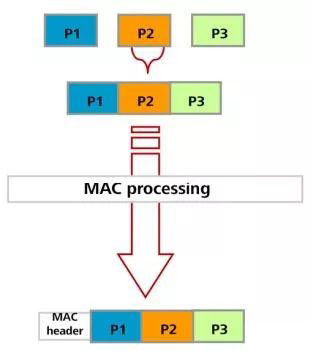
802.11ac
- The 802.11ac operating frequency band is 5GHz
- Maintain compatibility with old protocols. The physical layer frame structure is improved, and the channel management when different channel bandwidths coexist is considered
- In terms of security, it will fully comply with all contents of 802.11i security standard
- 802.11ac will help enterprises or families realize seamless roaming
- 802.11 can support 20m, 40m, 80m, 80 + 80m (discontinuous, non-overlapping), and 160m bandwidth, of which 20m, 40m, and 80m are required.
Advantages of 802.11ac:
- Higher throughput, 802.11ac WAVE2 can support up to 3.47gbps
- With less interference, the mainstream carrier frequency is 5G band
- More access provides greater throughput and multi-user MIMO, which objectively improves user access capabilities
MU-MIMO
MU-MIMO (multi-user multiple input multiple output) multi-user multi input multi output adopts display beamforming technology to realize signal propagation direction and reception control, send data to multiple terminals, and ensure that terminals do not interfere with each other. After MU-MIMO, the AP spatial stream can be flexibly allocated to multiple terminals for data transmission, which alleviates the problem of mismatch between the capacity of AP and the terminal spatial stream, and gives full play to the performance of AP.

Single user MIMO can greatly increase the throughput of single user, but a large number of terminals in the current network are still single stream. Compared with multi stream terminals, single stream terminals need to occupy more air port time to transmit data of the same size. Therefore, single stream terminals have also become a bottleneck in increasing the number of users. Multi user MIMO is a good way to solve this problem. Without changing the user bandwidth and frequency, an AP sends different data to multiple users (up to 4 users) at the same time.
A-MPDU extension
In 802.11ac, in order to further improve efficiency and reliability, the size of MPDU frame and A-MPDU frame are increased, and the length is limited from 64K to 1. 802.11ac only supports A-MPDU
RTS/CTS
RTS/CTS (request to send / clear to send) handshake protocol can avoid data transmission failure caused by channel conflict. When the AP sends data to a client, the AP will send an RTS message to the client, so that all devices within the AP coverage will not send data within the specified time after receiving RTs. After receiving RTS, the destination client sends a CTS message, so that all devices within the coverage of the client will not send data within the specified time.
In 802.11ac, RTS / CTS mechanism is defined to coordinate when and which channels are available. The specific mechanism is as follows:
- 802.11ac equipment sends RTs in the subchannel of 20MHz in the channel it uses. When the channel bandwidth is 80m, copy three copies to fill 80MHz; When the channel bandwidth is 160MHz, copy 7 copies and fill 160MHz. In this way, no matter whether the primary channel of the peripheral device is 80m or any 20m of the 160m channel, the RTS message can be listened to. Each device that receives the RTS message sets the virtual carrier listening to busy.
- The equipment receiving RTS messages will detect whether its main channel or other subchannels within 80m bandwidth are busy. If part of the channel bandwidth is used, the receiving device will only respond to the available 20MHz sub bandwidth within the CTS frame and report the duplicate bandwidth.
- Reply CTS message on each available 20m subchannel, so that the transmitting equipment can know which channels are available and which channels are not available. Finally, data is sent only on available channels.
- *RTS and CTS support dynamic bandwidth mode. In this mode, if part of the bandwidth has been occupied, CTS frames are only sent on the main channel. The customer sta sending RTS frame can fall back to a lower frequency wide mode
